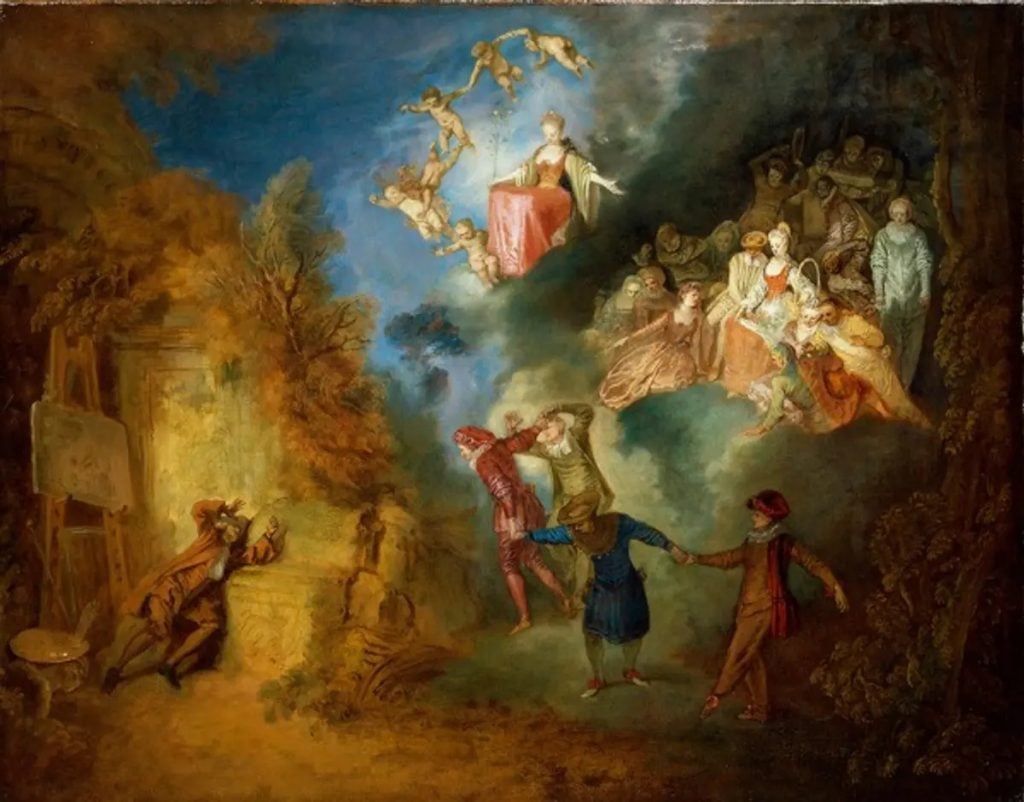Art World
$8 Million Rococo Masterpiece Barred from Leaving the U.K.
The 18th-century painting was owned by the U.K.'s first ever prime minister Sir Robert Walpole.

The 18th-century painting was owned by the U.K.'s first ever prime minister Sir Robert Walpole.

Jo Lawson-Tancred

The U.K. government is hoping to save a painting by the 18th century artist Jean-Antoine Watteau for the nation. Le Rêve de L’Artiste (1710), valued at just over £6 million ($7.9 million), has been temporarily barred from leaving the country until November 29, buying time for a domestic collection to acquire it.
Despite its French origins, the Rococo masterpiece has strong historical ties to Britain, having been acquired in 1736 by the country’s very first prime minister Sir Robert Walpole. It hung in his wife’s dressing room at 10 Downing Street, the prime minister’s official residence and the U.K. equivalent of the White House.
The work’s name translates to “The Dream of the Artist,” and the semi-fantastical painting is composed of distinct vignettes of dancing revelers, cherubs, and other motifs familiar from Watteau’s work like the commedia dell’arte figure Pierrot.
The French painter was celebrated across Europe for his charming fête galante paintings, a celebration of pastoral frivolities and, unwittingly, a last hurrah for France’s ancien regime before the aristocracy was sent to the guillotine. Le Rêve is uniquely complex in the artist’s oeuvre, apparently providing a meta exploration of how these partially-imagined scenes arrived to Watteau.
“This beautiful, enigmatic painting showcases Watteau’s extraordinary originality, and provides us with one of Western art’s earliest and most profound representations of the process of artistic creativity,” commented Mark Hallett, a prominent art historian who was on the committee that advised the U.K. government on Le Rêve. “It gives us a fascinating insight not only into Watteau’s thinking as a painter, but into wider eighteenth-century concepts of inspiration and imagination.”
“This is a work that cries out for further research, interpretation and appreciation, and that fully deserves being retained for the nation,” he added.
The decision to withhold an export license for Le Rêve was made by the U.K.’s arts minister Chris Bryant on the advice of the Reviewing Committee on the Export of Works of Art and Objects of National Interest. According to a press release, the painting was considered for “its outstanding significance to the study of the collections in which this picture was included as well as the early and highly unusual depiction of dream imagery.”
Further, Bryant said the work offers, “insights into the tastes and development of art in Britain in the 18th century. It portrays the artist’s dream, but perhaps its surreal fantasia inspired political dreams as well. Either way, it is an important and unusual work by a genius.”
At the end of the first deferral period (November 29), the owners will consider any offers to purchase the painting at the recommended price. According to the Department of Culture, Media, and Sport, the export bar can be renewed for a further six months if there is a serious expression of interest to purchase the painting.
Just a few weeks ago, the U.K. barred the export of two notebooks by the legendary British mathematician and computer scientist Alan Turing, giving a domestic buyer until November 15 to raise the £397,680 ($516,000) necessarily to acquire the artifacts.
At the start of the year, the U.K. temporarily barred the export of a rare 12th-century ivory statue, Deposition from the Cross (ca. 1190-1200), which had been privately sold by Sotheby’s to the Met in New York for more than $2.5 million. Before that, the item had been on long term loan to the V&A from 1982 through 2022. This summer, the London museum announced that it had successfully acquired the precious artifact.
“I am thrilled that the V&A has been able to save this elemental object of English art for the nation,” said Tristram Hunt, the V&A’s director. “In this small, sublime carving is captured a lost story of Christian culture, Romanesque design, and medieval craftsmanship.”